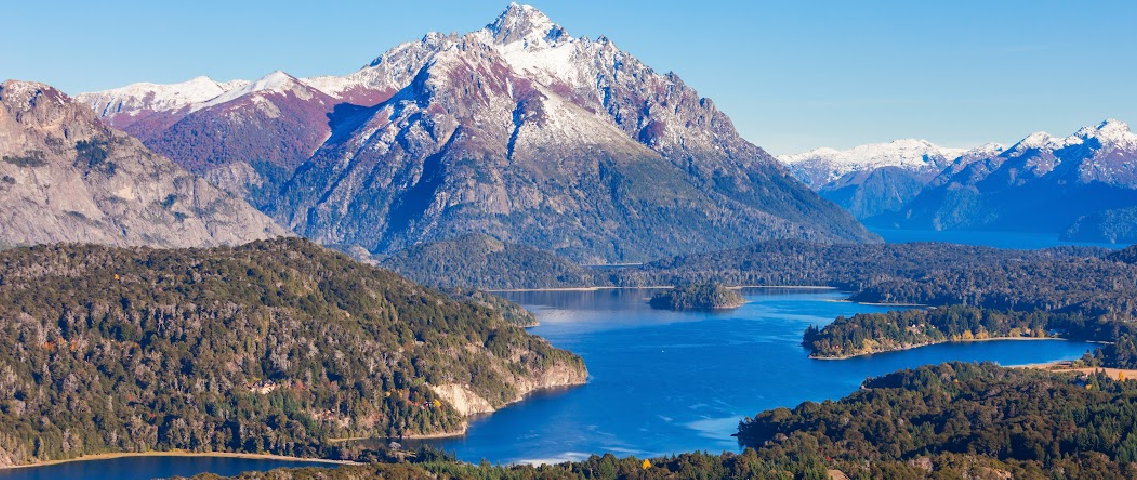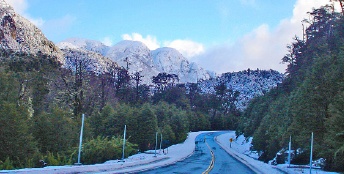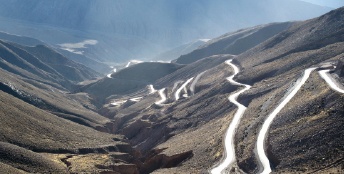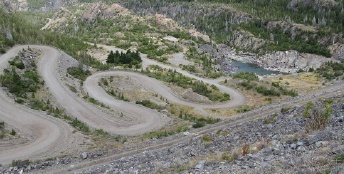
Did you know that the vast territories of Chile and Argentina can offer the opportunity to connect with nature differently?
It is the majestic Andes that provides a breathtaking natural border between Chile and Argentina, offering enriching travel experiences, where each twist in the road reveals volcanoes, shimmering lakes, glaciers, and incredible flora and fauna. Here’s your go-to guide for the best border routes to include in your itineraries.
Scenic Crossings between Chile & Argentina
Los Libertadores Pass (Santiago – Mendoza)
This is the most popular and busiest crossing, connecting Mendoza, Argentina, with Santiago, Chile. The route features rugged Andes mountain views, winding roads with hairpin turns. The road connects incredible cities from Valparaiso’s charming coasts and bohemian neighborhoods to Santiago, cosmopolitan atmosphere, the nearest ski resorts, and wine regions to indulge in Mendoza wine culture and gastronomy. During the journey, many outdoor activities are available.
Highlights of the route:
- Enjoy incredible panoramic views of the mountainous scenery
- Find the Christ the Redeemer, a 4-meter-tall statue.
- Admire the Mount Aconcagua, the highest peak in the Americas.
- Visit Ski Portillo, one of the oldest and most important ski resorts in the southern hemisphere.
Recommendations:
- A convenient and economical way is to cross this region by bus. It takes several hours, but it is worth it. It is better to travel during daylight to fully enjoy the views.
- Booking bus tickets in advance is advised, especially in high season.
- Consider that the weather conditions may cause closures on the road, especially during winter.
- The route can be challenging for those prone to motion sickness due to elevation and curves.
Cardenal Samoré Pass (Puerto Varas – Bariloche)
This crossing links San Carlos de Bariloche in Argentina with Puerto Varas in Chile’s Lake District. The route goes along the Nahuel Huapi Lake, featuring cascading waterfalls, native forests, and views of snow-capped volcanoes. The landscape is lush and emerald green due to abundant rainfall, with parts of the route passing through Puyehue National Park and Chilean virgin forests.
Highlights of the route:
- Lush forests, lakes, and volcanic landscapes in the Chilean Lake District and Argentine Patagonia.
- Easy access to Puyehue National Park & Angostura Village
- Enjoy outdoor sports and activities such as hiking, fishing, horseback riding, climbing, skiing
Recommendations:
- Easily accessible by public transport, including buses and private transfers. The journey typically takes about 2.5 hours, covering 160 km of scenic beauty, but it depends on the stops you make.
- This crossing is well-equipped and relatively straightforward.
Andean Crossing (Lake crossing from Puerto Montt or Puerto Varas to Bariloche)
This journey typically involves boarding a ferry from Puerto Varas or Puerto Montt in Chile to cross Todos los Santos Lake. Then, once travelers reach Peulla port in Chile, they are transported by bus to continue to Bariloche in Argentina.
Highlights of the route:
- Navigate through Nahuel Huapi Lake, Frías Lake, and Lake Todos Los Santos.
- Witness stunning views of the Andes mountain range, dense forests, crystal-clear lakes, glaciers, and iconic volcanoes like Osorno and Tronador, as well as Puntiagudo Hill and Calbuco Volcano
- The crossing traverses Nahuel Huapi National Park in Argentina and Vicente Pérez Rosales National Park in Chile.
Recommendations:
- The entire crossing can take around 6–8 hours, depending on waiting times at the border and the schedule of ferries and buses.
- The crossing involves multiple transfers and boat rides; light luggage is recommended.
- The crossing is a full-day commitment, so plan accordingly for onward travel.
Futaleufú Pass (Futaleufú and Chiloé Island)
This cross-border connects Trevelin and Esquel in Argentina with Futaleufú and Chiloé Island in Chile. It is one of the popular crossings as it is the gateway to the scenic Carretera Austral.
Highlights of the route:
- On the Argentine side: Visit the Alerces National Park and visit Trevelin in October for its stunning tulip fields.
- On the Chilean side: Explore the mythical charm, traditions, and flavors of Chiloé Island and be amazed by the untouched beauty of Futaleufu Reserve.
- Opportunities for hiking, biking, horse riding, and immersive stays in local lodges or farmsteads.
- It allows extended road trips into Patagonia.
Jeinimeni River Pass (Chile Chico to Los Antiguos)
This cross-border is located in the north of Patagonia, and by land it crosses the Jeinimen River, ideal for vehicles. However, more to the south, O’Higgins Lake is a perfect route for cyclists or backpackers crossing between Villa O’Higgins and El Chalten.
Highlights of the route:
- Cross the remote and wonderful Patagonian steppe.
- Access to General Carrera Lake (Chile) and Buenos Aires Lake (Argentina), both renowned for their turquoise waters and marble caves.
- Hike in some of the most famous mountains in the world in El Chalten
Recommendations
- Crossing the region of the Jeinimeni River requires a 4×4 vehicle. Also, crossing between Villa O’Higgins and El Chalten is more challenging due to the off-road route includes wild landscapes, narrow trails, and two ferry rides.
- Suitable for those seeking a quiet, scenic crossing and interested in geology, fishing, and rural Patagonian culture.
- This route is ideal for planning a multi-day itinerary in the Argentine & Chilean Patagonia.
Don Guillermo River Pass (Puerto Natales-El Calafate)
It is a key border crossing in northern Chilean Patagonia, connecting Argentina’s Santa Cruz province with Chile’s Magallanes and Chilean Antarctica Region. This crossing is strategically important for travelers moving between two major tourist hubs: El Calafate, Argentina, and Puerto Natales, Chile, gateway towns to the iconic Los Glaciares and Torres del Paine National Parks, respectively.
Highlights of the route:
- Ideal for traveling between Torres del Paine National Park in Chile and Los Glaciares National Park in Argentina
- Travelers can pass through the windswept steppe and dramatic mountain scenery typical of Patagonia.
Recommendations:
- The trip takes around 5 to 6 hours, including the border crossing. There are bus services available connecting Puerto Natales, Cerro Castillo, and El Calafate. If you prefer a private transfer, it is recommended to drive vehicles suitable for gravel roads.
- This crossing is essential for itineraries linking Chilean and Argentine Patagonia, especially multi-day treks or tours combining Torres del Paine and Perito Moreno Glacier.
Jama Pass (San Pedro de Atacama – Salta)
This northern crossing traverses the high Andes deserted landscape, including colorful rock formations, salt lakes like Salar de Aguas Calientes. The altitude reaches about 4,200 meters, offering spectacular mountain views and desert scenery.
Highlights:
- Admire surreal landscapes, such as salt flats, salt lagoons, volcanoes, and multicolored mountains.
- Pass through the Atacama Desert and the Argentine pampa.
Recommendations:
- The crossing can be lengthy due to altitude and customs procedures, often taking several hours.
- Buses operate this route, taking about 10–12 hours from San Pedro de Atacama to Salta. Buses typically run once a day, so it’s essential to confirm schedules and book ahead.
- Private transfers are available and usually take around 8–10 hours, offering a comfortable experience and allowing you to make stops for sightseeing.
- It is recommended for experienced travelers interested in high-altitude desert landscapes, indigenous culture, and less touristy routes.
- Be aware that there are limited facilities available, such as ATMs, gas stations, or stores. You should bring the necessary items for the trip, including cash or food.
Southern Integration & San Sebastian Pass
This is the southernmost border crossing between Argentina and Chile, located in Tierra del Fuego. If you are driving from Torres del Paine, you will pass through Puerto Natales until you arrive at Punta Delgada to take a ferry to cross the Strait of Magellan and connect with the mainland. This route to Ushuaia offers a striking transition from vast, desolate landscapes to lush, mountainous scenery as you approach the southernmost city on Earth — truly a journey to the end of the world.
Highlights of the route:
- You can tour Punta Arenas and Ushuaia, the southernmost cities on the continent.
- Explore the Tierra del Fuego National Park and the Beagle Channel
- Have a unique encounter with iconic wildlife such as guanacos, foxes, penguins, and enjoy windswept steppes, icy landscapes, and the gateway to Antarctica.
Recommendations:
- Open year-round, but weather can be harsh; check schedules and road conditions.
- It is recommended for adventurers and wildlife enthusiasts.
Requirements, Tips & Information for travelers for all Crossings
- Travelers need passports with at least six months’ validity, with required visas (if applicable), tourist cards, and proof of onward travel are necessary.
- Check the requirements for entering Chile and Argentina before your trip. Ask for more information from your travel agent.
- Comply with customs regulations, especially regarding plant and animal products.
- Encourage daytime crossings for the best views, especially on Los Libertadores and Cardenal Samoré.
- Some remote passes may have limited hours or seasonal closures; always verify before including them in itineraries.
- It is suggested to get acclimatized previously due to the high altitudes of some regions.
- Book in advance, especially on holidays and the summer season
- Consider extra time in your itinerary, as the times of crossing may vary based on the season and traffic volume.
Looking to wow your clients with one-of-a-kind cross-border adventures? Get in touch with us to help you craft unforgettable Chile-Argentina travel packages.



Published in April 2025













